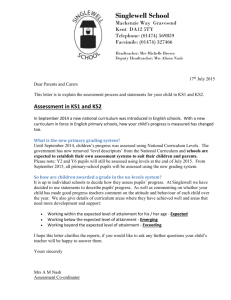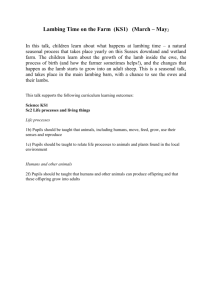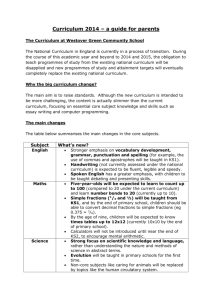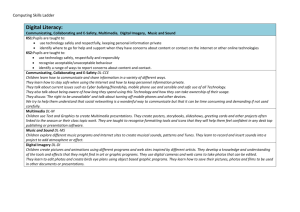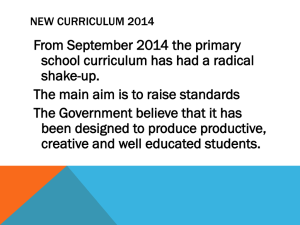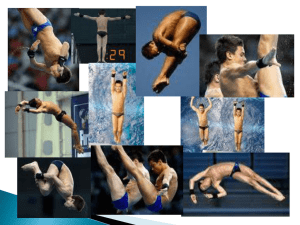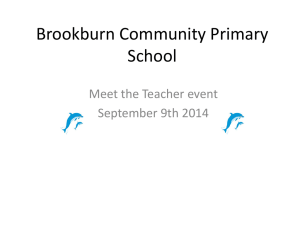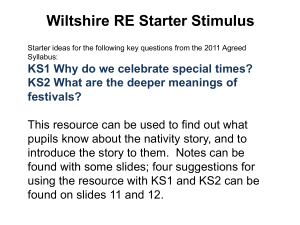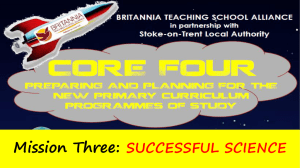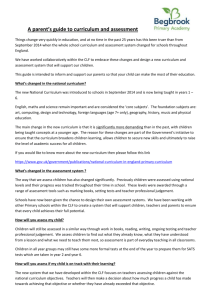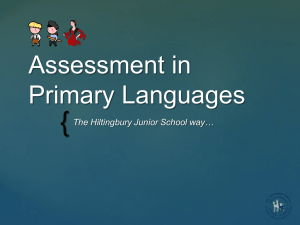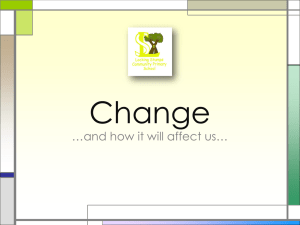Parent Forum Nov 14 - Paradise Primary School
advertisement
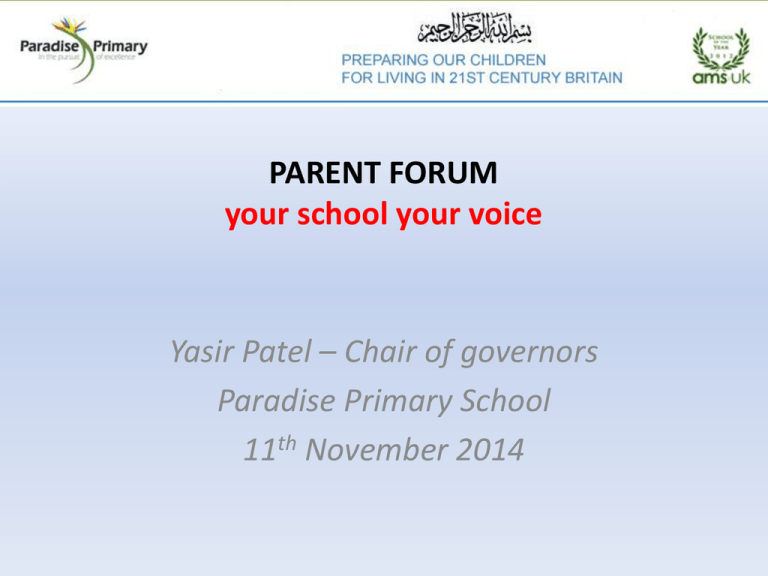
PARENT FORUM your school your voice Yasir Patel – Chair of governors Paradise Primary School 11th November 2014 EY Levels 1 = Emerging 2 = Expected 3 = Exceeding Primary – New curriculum Why the big curriculum change? The main aim is to raise standards, particularly as the UK is slipping down international student assessment league tables. Inspired by what is taught in the world’s most successful school systems, including Hong Kong, Singapore and Finland, as well as in the best UK schools, it’s designed to produce productive, creative and well educated students. • Although the new curriculum is intended to be more challenging, the content is actually slimmer than the current curriculum, focusing on essential core subject knowledge and skills such as essay writing and computer programming. It also follows on from similar curriculum revamp in Scotland and Wales which were implemented in 2010 and 2008 respectively and have a similar focus on excellence and core skills. What are the main changes? English • Stronger emphasis on vocabulary development, grammar, punctuation and spelling (for example, the use of commas and apostrophes will be taught in KS1) • Handwriting – not currently assessed under the national curriculum – is expected to be fluent, legible and speedy • Spoken English has a greater emphasis, with children to be taught debating and presenting skills. • Maths • Five-year-olds will be expected to learn to count up to 100 (compared to 20 under the current curriculum) and learn number bonds to 20 (currently up to 10) • Simple fractions (1/4 and 1/2) will be taught from KS1, and by the end of primary school, children should be able to convert decimal fractions to simple fractions • By the age of nine, children will be expected to know times tables up to 12x12 (currently 10x10 by the end of primary school) • Calculators will not be introduced until near the end of KS2, to encourage mental arithmetic Science • Strong focus on scientific knowledge and language, rather than understanding the nature and methods of science. • Non-core subjects like caring for animals will be replaced by topics like the human circulatory system. Design & technology • Afforded greater importance under the new curriculum, setting children on the path to becoming the designers and engineers of the future. • More sophisticated use of design equipment such as electronics and robotics. • In KS2, children will learn about how key events and individuals in design and technology have shaped the world. ICT • Computing replaces Information and Communication Technology (ICT), with a greater focus on programming rather than on operating programs. • From age five, children will learn to write and test simple programs, and to organise, store and retrieve data • From seven, they will be taught to understand computer networks, including the internet • Internet safety – currently only taught from 11-16 – will be taught in primary schools Languages Currently not statutory, a modern foreign language or ancient language (Latin or Greek) will be mandatory in KS2 Children will be expected to master basic grammar and accurate pronunciation and to converse, present, read and write in the language. The Arabic curriculum will remain the same for us starting from reception class – year 6. Islaaamiyah and PSHCE • No change in our current Islaamiyah curriculum. • Strong focus on SMSCD Primary – Levels, Change and why A New Approach to Tracking Pupil Progress (Primary) - developed by Paradise Primary Introduction The system of levels, which has been in place for over 20 years, will not fit the new National Curriculum, because the curriculum content has changed or moved around. The new curriculum sets out what is to be taught within each year, but does not provide any system or structure for the ongoing assessment of pupils’ progress. Paradise Primary has developed a new set of detailed assessment criteria – matched to the expectations of the new primary National Curriculum – which teachers can use to assess children’s understanding and determine the appropriate next steps. We have also explored various different ideas about how attainment and progress might be tracked in an in-house management information system, to assist our school with self-evaluation and to inform discussions with Ofsted. This document sets out this new approach. Key principles The criteria we are developing across the curriculum will be useful for teachers to use in a formative way, and hence teachers may refer to these frequently throughout the year. This will help with strategic decisions and early intervention. However the system of ‘measuring’ attainment, which is set out below, is a summative assessment tool only – taking a step back to reflect on the ‘big picture’ of where a child is in their learning journey –these judgements are made no more frequently than once per term. ‘Big picture’ criteria can be useful for teachers when considering a pupil’s next steps and giving feedback; however a good understanding of the success criteria for the specific focus of learning is the most useful basis for feedback to pupils. Key aims of this system The system needs to be simple – so that it can easily be understood at a glance by internal and external users of the data The system needs to provide users with key performance indicators about the attainment and progress of children, which will inform self-evaluation and form a good starting point for demonstrating progress to Ofsted The system needs to enable users to determine with confidence whether or not children are on track to meet the expected standards in the statutory assessments which will take place at the ends of KS1 and KS2 The terminology used needs to take account of the potentially harmful effects when describing the attainment of pupils who are working below the age-related expectation, e.g. pupils with SEN/D Details of the new system We have produced detailed criteria that relate to the skills and knowledge that children should be acquiring and developing over time. The curriculum sets out content in terms of year groups and Points– it therefore seems logical to adopt this approach for assessment and tracking progress. However we have reservations about adopting language such as ‘working at/below the expected level for Year 3’ – see the 4th bullet point under ‘Key aims’ above. We have therefore developed the following approach based on points. The summative judgements are based upon the extent to which a pupil is showing a secure grasp of those skills, using a ‘best fit’ approach. Teachers will therefore need to consider: the ‘NOFAN’ approach (which stands for Never, Occasionally, Frequently, Always, Naturally) – which represents the process of becoming secure in a new skill* the overall proportion of the criteria in which a child is showing a secure grasp * for the purposes of this system, ‘Frequently’ showing evidence of understanding of a skill is taken to mean a secure grasp of that skill Example of Year 1 Numeracy criteria. Y1 teacher would enter 1 in the cell under the objective once the teacher is confident it is met, then decide which of the following 3 descriptors is the best fit judgement: Developing, Secure or Mastering and also where the evidence comes from: Professional judgement, books or assessment. Measuring Attainment Once the expected number of objectives are met, evidence coming from professional judgement, books or assessment the system will generate a point score. Attainment and progress will be tracked with this point score, to assist our school with selfevaluation and to inform discussions with Ofsted. We would expect every child to make a minimum of 2 point progress in an academic year. To meet the national floor standard at KS1 a pupils should be on Point 5 at the end of year 2 and Point 12 at the end of year6. Understanding summery is matched to the expectations of the new primary National Curriculum – which teachers can use to assess children’s understanding and determine the appropriate next steps. Level Explanation • A child in-line with age related expectation will be given the level Expected. • A child working above the expectation will be Exceeding and the number after indicates by number of sub levels. • A child working below the expectation will be Emerging and the number after indicates by number of sub levels.
